- Home
- Frank Herbert
Destination Void Page 14
Destination Void Read online
Page 14
“The strangest thing,” Prudence said. “I feel as though I’d been a little bit asleep all along, not awake enough to realize what Bickel was driving at.”
“But now you’re beginning to get it,” Timberlake said.
“That storm of sense impressions doesn’t stop when you’re asleep,” Flattery argued. “Are you trying to tell me that sleep is a form of consciousness?”
As he spoke, he remembered making the same argument to Bickel, but now he had to be honest with himself and face up to the obvious answer plus everything that the answer implied.
“Yes, of course,” Flattery said. “Sleep’s a form of consciousness. It just falls near one end of the spectrum.”
“And all that unexplained energy?” Timberlake insisted.
“It has to be used for something,” Flattery said. “Yes, I see that.”
“All right,” Timberlake said. “The consciousness-effect—field or whatever—may mediate that energy balance. Perhaps it’s a homeostat.”
“All biological control mechanisms are homeostats,” Prudence said. “So what?”
“It’s not enough to say that consciousness juggles the storm of sense impressions,” Flattery said. “That still leaves your question unanswered, Tim. What happens to the energy?”
“There must be another effect somewhere in the system,” Timberlake said. “There has to be an unexplained flow of energy somewhere—or a flow that’s been explained the wrong—”
“Synergy,” Prudence said.
Flattery shot a surprised glance at her. The word had been on the tip of his tongue.
“Synergy,” Timberlake mused. “Any medical surprises in there?”
Prudence heard the question within the question. The life-systems engineer had a working acquaintance with synergy, but he wanted to know if a medical simplification might help him. Timberlake was sniffing down a hot trail.
“It’s the effect produced by our spinal reflexes,” she said. “Synergy acts through the cerebellum, an extra effect. It’s on the side of the … ahhh, circuit that leads out from the cortex.”
“We’re looking for an integrating or balancing effect,” Timberlake said.
“That’s … possible,” Flattery said.
This wasn’t enough for Timberlake. “Simple synaptic integration is enough on the side leading toward the cortex. Does synergy involve output from the frontal lobes or the gyrus? Could it account for our missing energy?”
“Why the gyrus?” Flattery asked.
“I keep looking for secondary mediation areas. We don’t dare overlook anything. We have to be right the first time or we go down the tube the same way all the other ships did.”
“You’re going around in circles the same way Bickel does,” Flattery objected. “So you narrow down the mediating area to the frontal lobes. So what?”
Timberlake wouldn’t be distracted. “Lot’s of researchers think the frontal lobes—”
“Fine!” Flattery interrupted. “No end of good people may’ve suggested that the frontal lobes are the mysterious center of consciousness. But Prue may be closer to it than you are. Motile, remember? There may be no seat of consciousness.”
Timberlake blinked. “What good does it do to know where it is if you don’t know what it is?”
Flattery pressed him. “Synergy may not be totally explained, but it’s still useful as a concept. However, if you’re suggesting that synergy is consciousness …”
“Dead end,” Timberlake said. “But Bickel thinks we’re after a field-regulating sensor which deals with mental and emotional responses.”
So that’s what’s bothering him! Prudence thought. She said aloud: “If we’re going to reproduce this thing artificially, whatever we build has to have sensory, mental, and emotional responses to regulate.”
Flattery pressed himself back into his couch. “Ahhhhh. We can give Bickel’s Ox its sensory and mental responses—but how do we give it emotions?”
“What about negative feedback?” Timberlake asked. “Emotions always involve a goal. Negative feedback suggests a goal-seeking element in the system.”
“Consciousness requires a goal?” Flattery asked.
He realized by the sudden silence greeting his question that they had lifted themselves to a critical point of this analysis. They could all feel it. Bickel’s challenging ideas had goaded them to this effort and now all of them were poised, sprinters waiting for the gun.
“A goal,” Timberlake whispered. His voice grew louder. “An object on which to focus.” He looked at Flattery. “The field relationship?”
Close, but not quite it, Prudence thought.
Flattery said: “Not an entity or a thing or an area of the brain, but a connecting link between such things or entities or areas.”
Out of the corner of his eye, Flattery saw Prudence adjust a dial on the big console. He sensed the waiting tensions in her movements.
“A bridge!” Timberlake shouted. “Of course! Of course! A bridge!”
“A bridge built out of language?” Prudence asked.
“But the symbols are loaded with errors, with weaknesses and flaws,” Timberlake said. “That’s it.”
Flattery saw a new quickness and sureness enter Prudence’s movements as she digested this.
“Time spanning,” she said. “With words … with symbols.”
And Flattery thought: There is a gateway to the imagination you must enter before you are conscious and the keys to the gate are symbols. You can carry ideas through the gate from one time-place to another time-place, but you must carry the ideas in symbols. Do you know, though, what you carry … and who it is that carries?
“Every symbol has hidden premises behind it,” Flattery said. “Every word carries unspoken assumptions.”
“And the most critical word in the whole problem is the word consciousness,” Timberlake said.
“Which assumes,” Prudence said, “that there is a self to be conscious.”
“A bridge crosses from one place to another place,” Timberlake went on. “If it starts breaking down, the engineers get out the original blueprints, the materials orders; and they go to the bridge and examine it. They study the bridge under static conditions and under loads. Then they may replace parts, put in new bracings—”
“Or tear the whole damn thing down and start over,” said Prudence. “Didn’t either one of you hear me? Our word assumes there’s a self to be conscious.”
“We heard you,” Flattery said. “But there are more important hidden assumptions than ‘Know thyself.’ “What about ‘Know thy limits’?”
“Limits,” Timberlake picked up the word. “At one end—sleep or the sleep of death; and at the other end—waking.”
“And the question of Western religion,” Flattery said, “is: What lies beyond death? But the question of the Zen master is: What lies beyond waking?”
“For Kee-rist’s sake!”
The voice was Bickel’s and it plunged down onto them from the command-circuit screen overhead.
Flattery looked up with a smug smile to find Bickel glaring down at him from the screen.
“I leave you for a half-hour, and you lure these poor fools down some mystical dead end! Tossing labels around just like those jackasses back at UMB! Zen master! Next you’ll trot out Cosmic Consciousness! Of all the impractical—”
“John, we’ve refined this question down to its essence,” Timberlake said. “If you’d—”
“I asked you to give me some circuit suggestions. I’ve been listening to you play verbal medicine ball for ten minutes, and what I want to know is this: How will all that yakking build one circuit? Just one circuit!”
“You yourself asked UMB to define consciousness,” Prudence protested.
“Because I wanted to keep them occupied and out of our hair.” The screen went blank.
Flattery looked over to the console in front of Prudence, saw that the command-circuit key pointed to “on,” but the screen remained blank.
But why was the screen blank?
As though she read his mind, Prudence said: “John’s installed an override on the command circuit. Any idea why?”
“Didn’t you see where he was?” Timberlake demanded. “He was in the shop—working on that Ox mess!”
Timberlake unlocked his action couch and, in almost the same motion, launched himself at the hatch to the computer maintenance shop. He wrenched at the lock dogs, but they remained immovable.
“He’s jammed the lock!” Timberlake’s voice rose in fear. “If he wrecks our computer …”
“You noticed … so you may as well watch,” taunted Bickel’s voice.
They looked up to see a view of the shop on their big screen. Bickel stood with the detritus of the initial Ox installation around him—dangling leads, meters, neuron blocks—all stacked precariously away from the computer wall.
“Bickel, listen to reason,” Timberlake pleaded. “You can’t just tear into—”
“Shut up or I’ll turn you off,” Bickel warned.
He knelt with a substitute neuron block, inserted it between the Ox and the computer wall, began making connections.
“Please, John,” Prudence begged, “if you’d—”
“You’re not going to stop him by talking to him,” Flattery said.
“Listen to Raj.” Bickel slipped another neuron block into place against the wall, made new connections.
“Rhythm,” he said. “I went to sleep on it … and it woke me up—that and your yakking. Rhythm.”
Another substitute neuron block went into place beneath the first two.
“Describe what you’re doing,” Flattery said, and he motioned for Timberlake to come to his side.
“Brain-vision anatomy can be reduced to the mathematical description of a scanning process,” Bickel answered. “It follows that any other brain-function anatomy—including consciousness—should submit to the same approach. I can duplicate the alpha-rhythm cycle for a brain-scanning sweep by setting it up in the time-cycle of these neuron blocks. If I trace each rhythm from a human model and duplicate—”
“What’s the function of each of these human rhythms?” Flattery demanded.
As he spoke, Flattery scribbled a note on a pad of ship flimsy, pressed it into Timberlake’s hand.
Timberlake looked up to the screen, but Bickel still had his back to the video eyes that matched the screen-view.
“We don’t know that function for certain, do we?” Flattery asked, and he motioned frantically for Timberlake to read the note.
Timberlake turned his attention onto the paper, read:
“Back way, around the hyb tanks. Bickel hasn’t jammed the hatch from quarters. Take the other tube and surprise him.”
Again, Timberlake looked up to the screen.
The Ox was taking on new shape under Bickel’s hands—reaching out to the angle of the shop against the computer wall. It began to assume a feeling of topological improbability in Timberlake’s eyes—with jutting triangles of plastic, oblongs of neuron couplers, strips of Eng multipliers … and the color-coded leads interweaving like a crazy spider web.
Timberlake felt a hand grab his arm, shake him. He looked at the hand, followed its arm to Flattery’s glaring face.
Flattery gestured to the note in Timberlake’s other hand.
Again, Timberlake looked at the note, recognizing why he remained rooted to this spot. Around the hyb tanks?
No.
It would have to be through the hyb tanks.
Flattery must know that.
Timberlake turned his tortured gaze on Flattery, bringing the terror up to full awareness. Bickel has infected me with his cynical skepticism. I’m afraid of what I’ll find in the hyb tanks if I look too close. I’ll find the tanks empty, and nothing but leads back into the computer from the tanks. And the computer will be programmed to simulate the presence of hybernating life in those tanks. The whole thing will turn out to be a monstrous hoax.
I’ll discover I’ve been life-systems engineer to … nothing.…
Why do I fear that? he wondered. Even this thought set him shivering.
Again, Flattery shook his arm.
Why doesn’t he go? Timberlake wondered. He’s so anxious!
The answer was obvious: Flattery wasn’t as knowledgeable about computers. He couldn’t analyze what Bickel was doing and repair—if that was possible—the damage.
I’m panic-stricken, Timberlake thought.
But he knew he couldn’t stay rooted here. He had to take that other passage. And when he got into the hyb tanks, he wouldn’t be able to resist the close inspection. He’d look beyond the dials and gauges and repeaters. He’d look into the tanks.
Despite his unexplainable terror, the other possibility remained—that the tanks contained life, and this life shared their danger.
Chapter 19
The cell has energies that oscillate and pulse with the tumult of living. We see reflections of this root-activity in that coordinated cell structure which we commonly refer to as a human being. Have you ever watched a man tapping his finger nervously on a desktop? Have you ever timed the periodicity of the human eyeblink? Breathing has characteristic rhythms for different conditions of the total cell structure. You must keep this in mind when you design devices to be used and occupied by this human bundle of cells. You must always remember the pulse and the needs of the component cells.
—Vincent Frame, Biochemist/Designer
I’ll use the shot-effect generator again, Bickel thought.
He leaned into the organized clutter of the Ox, clipped a lead onto the temporary input, threaded the lead out, and draped it to one side.
The effect and the way to achieve it were still clear in his mind. He had awakened suddenly, not knowing how long he had slept, but feeling refreshed and with this answer filling his mind.
He turned to the computer leads, linked the Ox through a buffer that would feed its impulses into a test-memory bank, connected this to the new bank of neuron blocks, and put the system on full interlock.
“Will you at least explain what you’re doing, John?” Flattery’s voice flowed out of the screen.”
Bickel glanced back, saw Prudence at the controls, Flattery sitting on the edge of an action couch—no sign of Timberlake. But this screen’s eyes didn’t expose all of Comcentral. It was probable that Timberlake was trying the hatch. Well let him.
“We have only ourselves to use as models for producing this Consciousness Function,” Bickel said. “And everybody keeps saying we can’t get into ourselves the way an engineer should to duplicate the mechanism. But, friend, there’s another approach—thoroughly tested and effective.”
Prudence said: “Raj?”
Flattery looked at her.
“I’m getting current drift on the auxiliary power supply.”
“It’s the shop,” Flattery stated flatly. “John’s taken a direct line to prevent us from shutting him off.” He looked back at Bickel. “Right?”
“Right. It shouldn’t cause you any trouble. I’ve isolated the line. Your main board is still functioning.” Bickel turned back to the Ox, began tying in a series of timed neurofibers.
“What’s the tested, effective method?” Flattery looked up at the telltales on the Com-central board, following Timberlake’s progress by the heat sensors. Timberlake was out in the second zone now, turning in toward the opposite side of the shielding and the hyb tanks.
Why was Tim so reluctant to go? Flattery wondered.
Bickel finished a triple connection along the timed fibers, straightened. “The system you can’t tear apart and examine is called a black box. If we can make a white box sufficiently similar and general in potential to the black box—that is, make it sufficiently complex—then we can force the black box, by its own operation, to transfer its pattern of action to the white box. We cross-link th
em and subject each to identical shot-effect bursts.”
“What’s your white box?” Flattery asked, his interest and attention caught in spite of his fears. “That thing?” He nodded toward the crazy-block construction of the Ox.
“Hell, no, this is nowhere near complex enough. But our entire computer system is.”
He’s gone crazy! Flattery thought. He can’t be suggesting seriously that he’d throw a scrambling shot- effect burst into the computer!
Again, Flattery glanced up at the telltales. Timberlake was at the edge of the hyb tanks, moving at a maddeningly slow pace.
“Then … how does the Ox function in this?” Flattery asked, returning his attention to the screen.
“This is our sorter,” Bickel said. “It sorts the rhythms of the system and acts as a crude set of frontal lobes.” He linked two parts of his construction by cross-jacks in a patchboard. “There. Now to run a few tests.”
“Shouldn’t you wait?” Flattery demanded. “Shouldn’t we discuss this a bit more? What if you’ve made a mistake and—”
“No mistake,” Bickel said.
Flattery looked to the telltales. Timberlake was in the hyb tanks now, but he wasn’t moving—just stopped there.
We set Bickel, our “organ of analysis,” at too high a pitch, Flattery thought. We should’ve known it could run wild.
What was keeping Timberlake?
“Straight-line test, first,” Bickel said, and closed a key on the computer wall. He stared at the diagnostic-circuit dials above him.
Flattery held his breath, turned slowly to look at the big board in front of Prudence. If Bickel’s test loused up the central computer system, it’d show up first on the big board.
The flashboard retained its quiet green. The steady ticking of relays through the graph counters and monitors held at an even pace. Everything appeared soothingly ordinary.
“I’m getting individual nerve-net responses on the separate blocks,” Bickel said.
Flattery kept his attention on the flashboard. If Bickel ruined the computer, the ship was dead. Most of the Tin Egg’s automatic systems depended on the computer’s inner lines of communication and supervisory control programs.

 Direct Descent
Direct Descent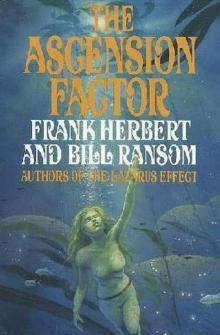 The Ascension Factor
The Ascension Factor The Heaven Makers
The Heaven Makers Children of Dune
Children of Dune Old Rambling House
Old Rambling House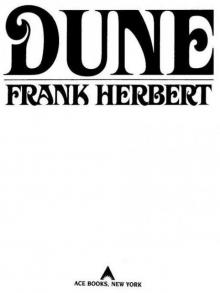 Dune
Dune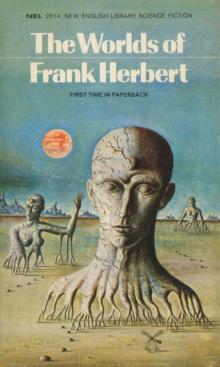 The Worlds of Frank Herbert
The Worlds of Frank Herbert The Jesus Incident
The Jesus Incident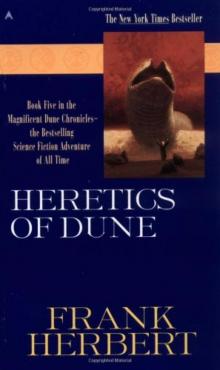 Heretics of Dune
Heretics of Dune Whipping Star
Whipping Star Dune Messiah
Dune Messiah Man of Two Worlds
Man of Two Worlds The Book of Frank Herbert
The Book of Frank Herbert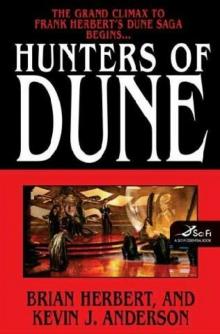 Hunters Of Dune
Hunters Of Dune The Tactful Saboteur
The Tactful Saboteur Soul Catcher
Soul Catcher God Emperor of Dune
God Emperor of Dune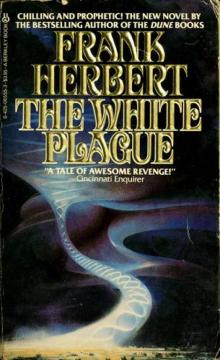 The White Plague
The White Plague The Green Brain
The Green Brain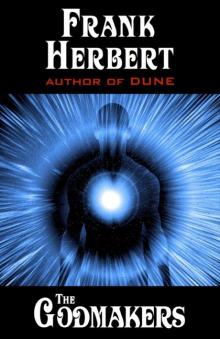 The Godmakers
The Godmakers Sandworms of Dune
Sandworms of Dune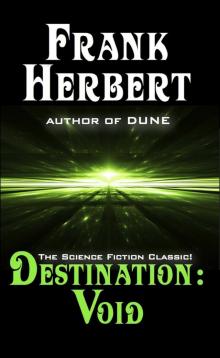 Destination Void
Destination Void The Dosadi Experiment
The Dosadi Experiment Eye
Eye High-Opp
High-Opp The Eyes of Heisenberg
The Eyes of Heisenberg Missing Link
Missing Link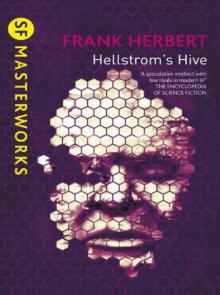 Hellstrom's Hive
Hellstrom's Hive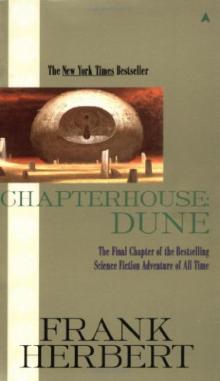 Chapterhouse: Dune
Chapterhouse: Dune The Santaroga Barrier
The Santaroga Barrier The Dragon in the Sea
The Dragon in the Sea Operation Haystack
Operation Haystack A Thorn in the Bush
A Thorn in the Bush Four Unpublished Novels
Four Unpublished Novels Dune dc-1
Dune dc-1 Jorj X. McKie 1 - Whipping Star
Jorj X. McKie 1 - Whipping Star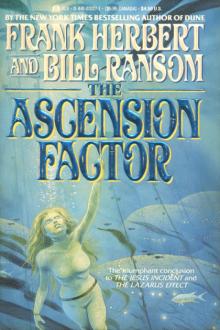 DV 4 - The Ascension Factor
DV 4 - The Ascension Factor Frank Herbert - Dune Book 4 - God Emperor Of Dune
Frank Herbert - Dune Book 4 - God Emperor Of Dune ChapterHouse: Dune dc-6
ChapterHouse: Dune dc-6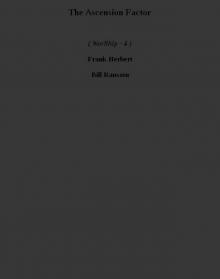 The Ascension Factor w-4
The Ascension Factor w-4 A Game of Authors
A Game of Authors Children of Dune dc-3
Children of Dune dc-3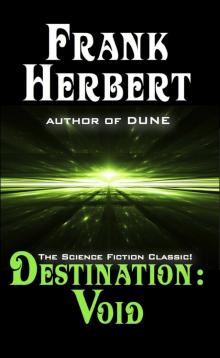 Destination: Void: Prequel to the Pandora Sequence
Destination: Void: Prequel to the Pandora Sequence The Collected Stories of Frank Herbert
The Collected Stories of Frank Herbert Dune Messiah dc-2
Dune Messiah dc-2 Frank Herbert - Dune Book 5 - Heretics of Dune
Frank Herbert - Dune Book 5 - Heretics of Dune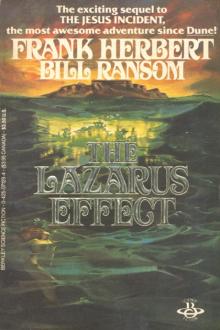 DV 3 - The Lazarus Effect
DV 3 - The Lazarus Effect The Jesus Incident w-2
The Jesus Incident w-2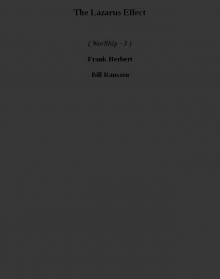 The Lazarus Effect w-3
The Lazarus Effect w-3 Frank Herbert
Frank Herbert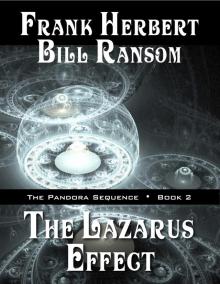 The Ascension Factor: Pandora Sequence
The Ascension Factor: Pandora Sequence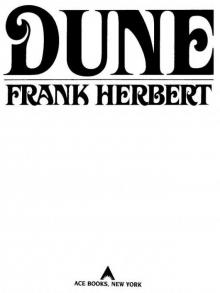 Dune (40th Anniversary Edition)
Dune (40th Anniversary Edition)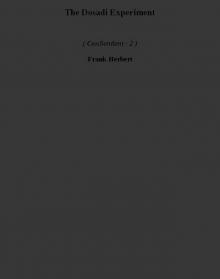 The Dosadi Experiment c-2
The Dosadi Experiment c-2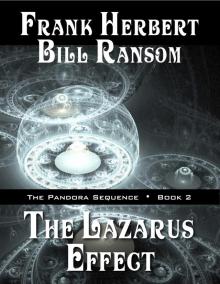 The Lazarus Effect
The Lazarus Effect God Emperor of Dune dc-4
God Emperor of Dune dc-4 The Pandora Sequence: The Jesus Incident, the Lazarus Effect, the Ascension Factor
The Pandora Sequence: The Jesus Incident, the Lazarus Effect, the Ascension Factor The Green Brain (v4.0)
The Green Brain (v4.0) The Heaven Makers (v4.0)
The Heaven Makers (v4.0) Heretics of Dune dc-5
Heretics of Dune dc-5